Watering Smart: The Key to Thriving Vertical Gardens 🌿
Efficient Irrigation in Indoor Vertical Gardens is essential for maintaining a healthy and thriving garden. Unlike traditional gardening, vertical gardens face unique challenges, such as limited soil capacity and gravity-driven drainage.
By mastering Efficient Irrigation in Indoor Vertical Gardens, you can optimize water use, prevent overwatering, and ensure even hydration across all your plants. 🌱💦
With the right strategies, you can maintain a thriving garden while conserving water and avoiding overwatering. 🌍💧
Let’s explore the most effective tips to optimize Efficient Irrigation in Indoor Vertical Gardens.
Why Efficient Irrigation Matters 🌟
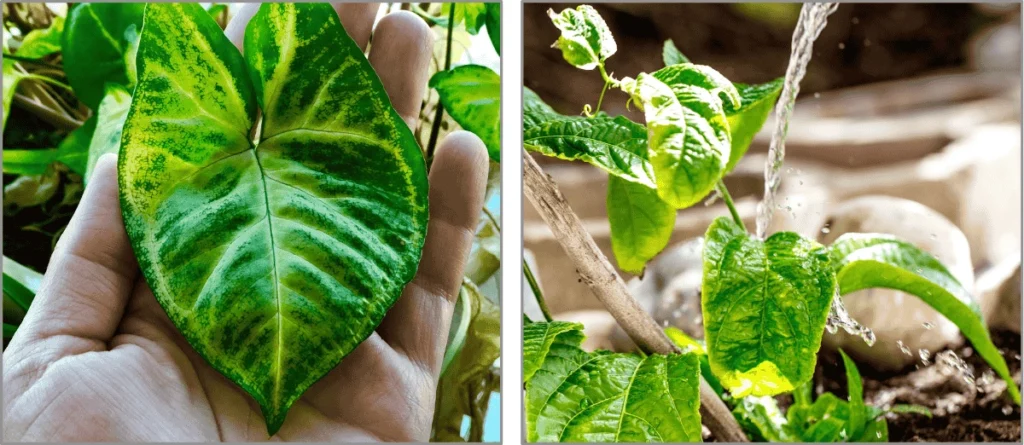
💧 Prevents Overwatering: Excess water can lead to root rot and fungal issues.
🌍 Saves Resources: Conserving water is environmentally and economically beneficial.
💦 Ensures Uniform Hydration: Distributes moisture evenly across all plants.
🛠️ Reduces Maintenance: Smart irrigation systems minimize manual effort.
Top Tips for Efficient Irrigation in Indoor Vertical Gardens✨
1. Use a Drip Irrigation System 💧
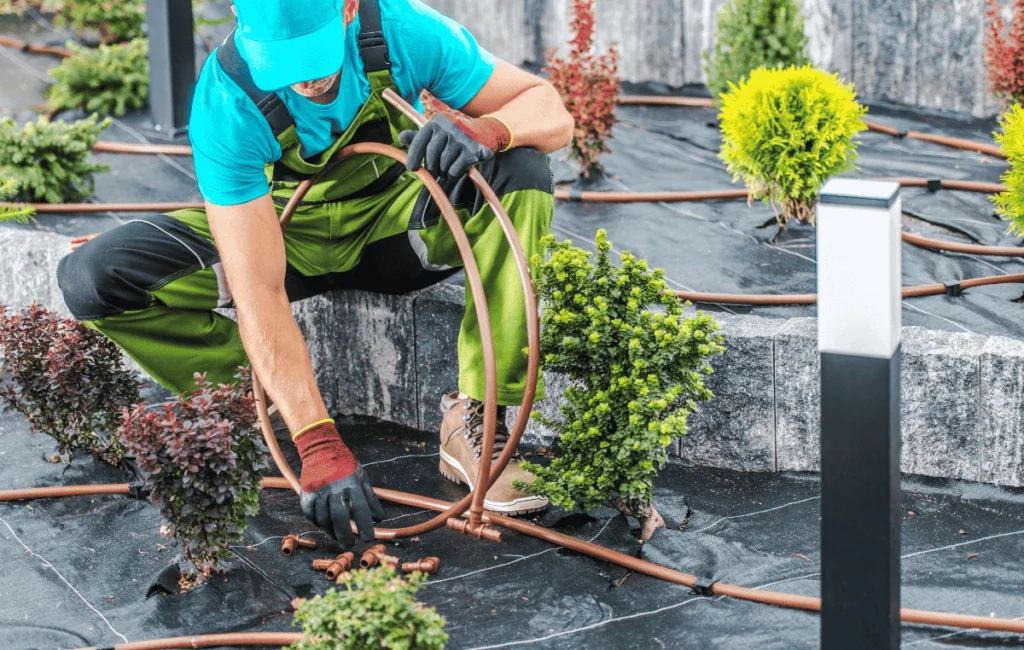
Drip irrigation is one of the most efficient methods for watering vertical gardens. This system delivers water directly to the root zone, minimizing waste and ensuring uniform hydration.
- How It Works: Tubes with small emitters release controlled amounts of water.
- Benefits: Reduces evaporation and prevents overwatering. 🌞
- Installation Tip: Position the emitters near the base of each plant for precise watering.
For a more detailed guide on how to install and optimize drip irrigation systems, check out this helpful article from The Spruce. 🌿💧
2. Incorporate Self-Watering Planters 🌸
Self-watering planters have built-in reservoirs that provide consistent moisture to plants over time.
Advantages: Ideal for busy schedules or frequent travelers. 🏖️
How to Use: Fill the reservoir, and the planter wicks water as needed.
Maintenance Tip: Clean the reservoir regularly to prevent algae growth.
3. Choose the Right Soil Mix 🌱
The soil in vertical gardens plays a crucial role in water retention.
- Best Option: Use lightweight, well-draining potting mixes that contain materials like perlite, coconut coir, or vermiculite.
- Pro Tip: Avoid heavy garden soil, as it can retain too much water and compact over time.
4. Group Plants by Water Needs 🌿💦
Different plants have varying water requirements. Grouping plants with similar needs simplifies irrigation and prevents overwatering or underwatering.
- Example:
- High water needs: Mint 🌿, basil 🌱, and parsley 🌿.
- Low water needs: Lavender 🌸, rosemary 🌿, and thyme 🌱.
- Irrigation Tip: Position thirstier plants closer to water sources.
5. Add a Waterproof Liner 💧
A waterproof liner at the back of your vertical garden prevents water from leaking onto walls or floors while directing excess moisture to a collection tray or drainage system.
- Benefits: Keeps your indoor space clean and dry.
- Installation Tip: Ensure the liner has a slight tilt to channel water properly.
6. Use a Timer for Automation ⏰
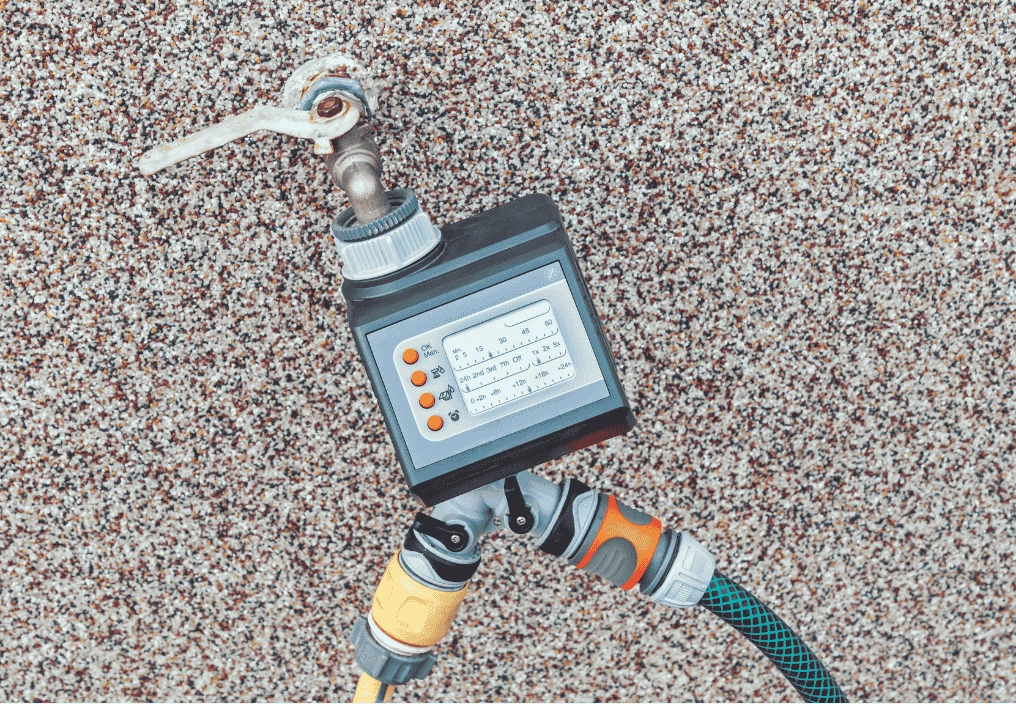
An automatic timer connected to your irrigation system ensures consistent watering without manual intervention.
- Advantages: Eliminates guesswork and ensures plants are watered even when you’re away 🏡.
- Pro Tip: Adjust the timer based on the season and plant growth stages 🌷.
7. Monitor Humidity Levels 🌡️
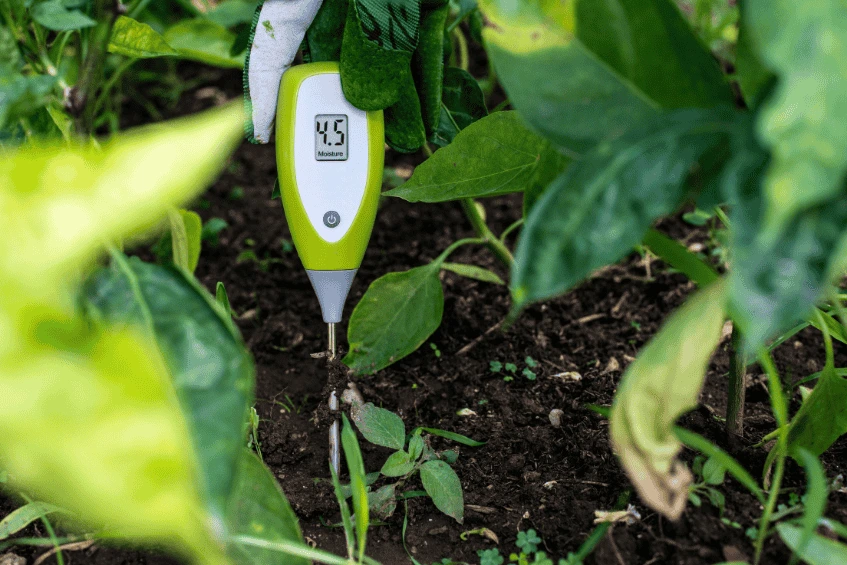
Indoor environments often have fluctuating humidity levels, which affect plant hydration.
- Solution: Use a hygrometer to monitor humidity and adjust watering schedules accordingly.
- Pro Tip: Mist plants occasionally to maintain adequate moisture in dry conditions 🌬️.
8. Regularly Check for Clogs 🛠️
Clogs in irrigation systems can disrupt water flow, especially in drip or automated setups.
- Maintenance Tip: Inspect tubes, emitters, and filters regularly to ensure smooth operation.
- Cleaning Tip: Use vinegar 🍋 or a mild detergent to clear mineral deposits or debris.
9. Utilize Mulch for Moisture Retention 🌾
A layer of mulch on top of the soil reduces evaporation and helps retain moisture.
- Materials: Use organic mulch like coconut husks, wood chips, or shredded leaves 🍂.
- Pro Tip: Mulch also suppresses weeds and adds a decorative touch 🌸.
10. Practice Spot Watering 💧
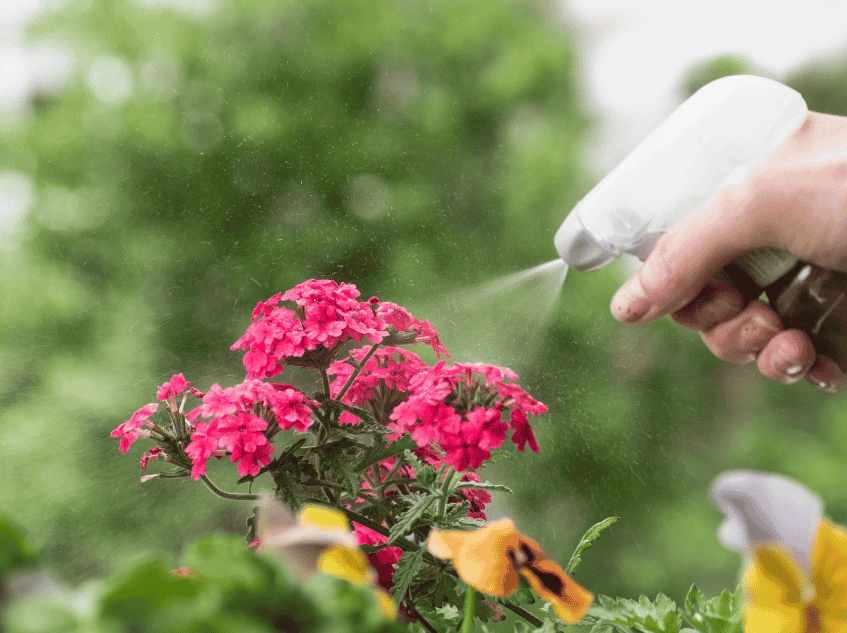
For smaller vertical gardens, spot watering with a watering can or spray bottle gives you control over each plant’s hydration needs.
- Best For: Gardens with a mix of high and low water-demand plants 🌱.
- Pro Tip: Use a watering can with a long spout for precise application.
Common Mistakes to Avoid 🚫
- Excess water: Can lead to root decay and encourage fungal growth.
- Underwatering: Causes plants to wilt and weakens their growth.
- Ignoring Drainage: Stagnant water can harm plant health and attract pests 🐜.
- Neglecting Regular Checks: Failing to monitor the irrigation system can result in unnoticed clogs or leaks.
Designing an Efficient Irrigation System 🛠️🌿
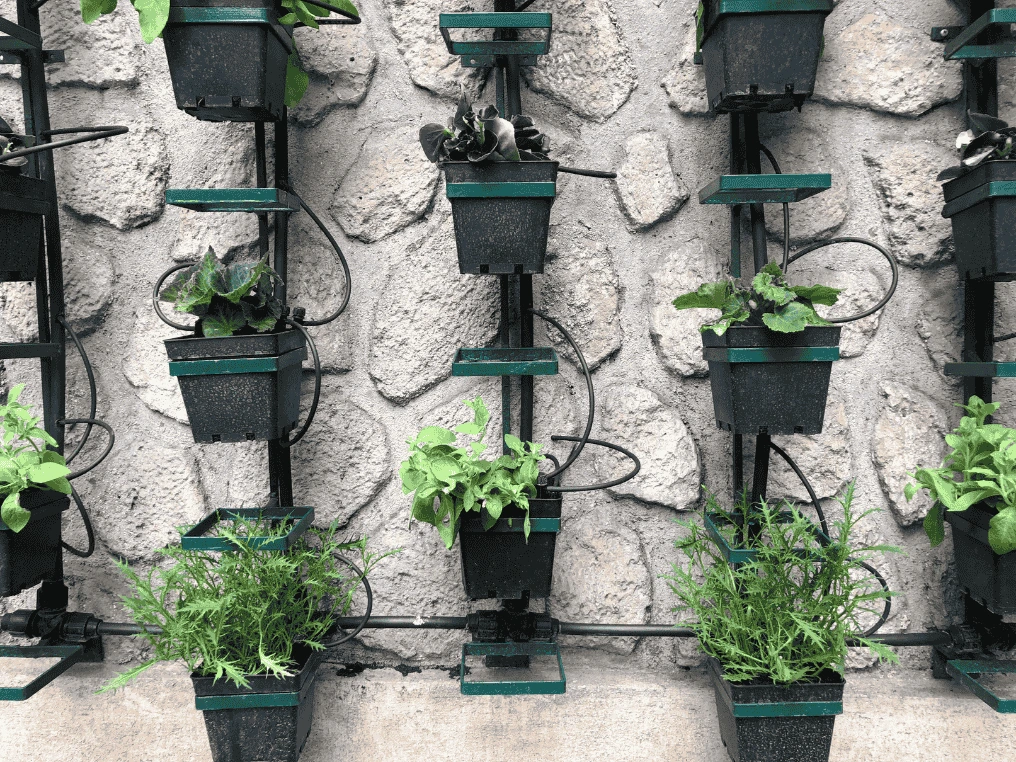
A well-designed drip irrigation system, as seen in the image, ensures efficient water distribution in vertical gardens 🌿💧, promoting healthy plant growth 🌱🌟.
- Start with a Plan: Map out your vertical garden’s layout and identify water access points.
- Install Drainage Trays: Collect excess water to avoid messes and reuse it if necessary. ♻️
- Combine Systems: Use a mix of drip irrigation and self-watering planters for diverse plant needs.
Practical Examples for Irrigation Techniques 🌟
1. Plants Benefiting from Each Technique 🌱
Each irrigation method suits specific plants based on their water needs. Here are some examples:
- Drip Irrigation:
Ideal for herbs and vegetables requiring a steady supply of water, such as:- 🌿 Basil: Thrives in consistently moist soil without being waterlogged.
- 🍅 Cherry Tomatoes: Drip irrigation prevents fruit cracking caused by soil moisture fluctuations.
- 🥬 Lettuce: Benefits from regular, uniform hydration.
- Self-Watering Planters:
Perfect for plants needing consistent moisture but with roots sensitive to overwatering, such as:- 🌱 Spinach: Prefers consistently moist soil and grows quickly in self-watering planters.
- 🥒 Cucumbers: Regular water supply promotes crisp fruits and prevents bitterness.
- 🌿 Mint: Requires moist soil and adapts well to self-watering systems.
2. Combining Irrigation Systems 🤝
In diverse vertical gardens, combining irrigation systems can optimize plant growth:
- Drip Irrigation + Self-Watering Planters:
For vertical gardens with plants of varying water needs, integrating drip irrigation at the top and self-watering planters at the bottom ensures efficiency.- On the top tier, use drip irrigation for water-demanding plants like lettuce 🥬 and basil 🌿.
- On lower tiers, install self-watering planters for drought-tolerant plants like thyme or rosemary🌱.
- Drip Irrigation + Spot Watering:
In smaller or mixed gardens, a drip irrigation system can be the base, while spot watering addresses individual plants not connected to the main system.- Example: Use drip irrigation for herbs 🌱 in the center and apply spot watering to ferns 🌿 on the edges.
3. Benefits of Combining Systems ⚙️
- Water Optimization: Reduces waste and prevents overwatering.
- Efficiency: Automates parts of the process, saving time on maintenance.
- Adaptability: Meets different hydration requirements within the same space.
Tip 💡:
Mastering efficient irrigation in indoor vertical gardens ensures your plants get the right amount of water for healthy growth. 🌿💧
For a helpful visual guide on setting up an automatic irrigation system, watch the video below:
👇 Water Wise Automatic Watering System | How To | Proven Winners 📹
FAQ: Common Questions About Irrigation for Vertical Gardens ❓
How often should I water my vertical garden?
Watering frequency depends on plant type, soil, and environmental conditions. Generally, check soil moisture daily and water when the top inch feels dry.
Can I use tap water for irrigation?
Yes, but if your water is high in chlorine or minerals, consider filtering it to prevent long-term harm to plants.
What’s the best irrigation system for beginners?
A simple drip irrigation kit is ideal for beginners as it’s easy to install and maintain.
Do vertical gardens need fertilizer in the irrigation system?
Adding a water-soluble fertilizer periodically can enhance plant growth, but avoid over-fertilizing to prevent nutrient build-up.
Where can I learn more about irrigation systems?
Check out our comprehensive guide on the 5 Automated Irrigation Systems for Vertical Gardens.
Nurture with Precision 🌱💧
Creating Efficient Irrigation in Indoor Vertical Gardens is simple with these strategies, ensuring thriving plants and steady growth.🌱💧
Whether you choose to automate with drip systems or stick to hands-on spot watering, the key is to adapt to your plants’ specific needs. 🌱
Start optimizing your Efficient Irrigation in Indoor Vertical Gardens today, and watch your vertical garden flourish with health and beauty! 🌸🌿

